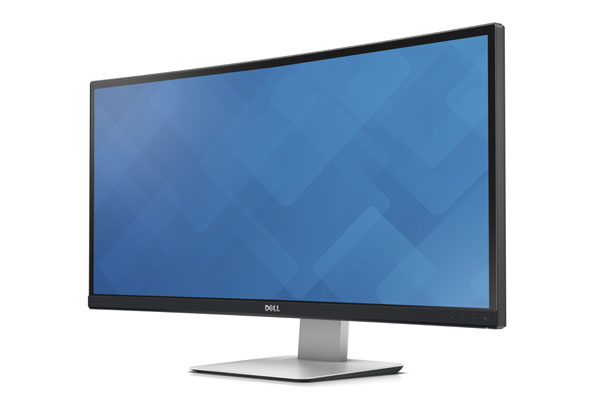Dell Debuts 34-inch 21:9 Curved Monitor At CES
The curve is in at this year's CES with screens in both 16:9 and 21:9 aspect ratios debuting from multiple manufacturers. Dell's new addition to the genre is the U3415W.
As we've seen with similar displays from LG (34UC97), HP (Z34c) and Samsung (SE790C), the ultra-wide form factor really becomes special when you add in a subtle curve to the screen. Pixel density is the same 109 ppi as a QHD display in the 27-inch size. In our opinion, this is the sweet spot for font rendering and sizing in Windows. As much as we like the extra resolution of an Ultra HD screen, text becomes extremely small even on a 32-inch monitor. QHD (2560 x 1440) or UQHD (3440 x 1440) has become our favorite workplace display for not only productivity, but gaming and entertainment as well.
The U3415W offers the same sRGB 10-bit color gamut and 300cd/m2 brightness as the competition but adds two 18-watt speakers and an HDMI 2.0 port to the mix. In addition to the DisplayPort input, you also get an output which lets you daisy-chain two monitors to a single video card output using MST, which makes multi-screen installations a snap.
The stand allows for full swivel, tilt and height adjustments, and for those wishing to use their own bracket, a 100 mm VESA mount is provided around back. Rounding out the package is a three year warranty with Advanced Exchange Service.
Our full hands-on review of the LG 34UC97 will publish soon, and we expect several more to follow based on the plethora of curved-monitor introductions at CES. Last year seemed to be all about 4K, and this year it's nothing but the curve. From what we've seen so far, this is a trend that no one asked for but may just catch on with users.
Follow us @tomshardware, on Facebook and on Google+.
Get Tom's Hardware's best news and in-depth reviews, straight to your inbox.

Christian Eberle is a Contributing Editor for Tom's Hardware US. He's a veteran reviewer of A/V equipment, specializing in monitors. Christian began his obsession with tech when he built his first PC in 1991, a 286 running DOS 3.0 at a blazing 12MHz. In 2006, he undertook training from the Imaging Science Foundation in video calibration and testing and thus started a passion for precise imaging that persists to this day. He is also a professional musician with a degree from the New England Conservatory as a classical bassoonist which he used to good effect as a performer with the West Point Army Band from 1987 to 2013. He enjoys watching movies and listening to high-end audio in his custom-built home theater and can be seen riding trails near his home on a race-ready ICE VTX recumbent trike. Christian enjoys the endless summer in Florida where he lives with his wife and Chihuahua and plays with orchestras around the state.
-
Murissokah According to Dell, it actually sports a dual 9w audio solution, and not 2x18w as described in the article (which would be suspiciously high for a monitor). Other sources have stated that the built-in USB 3.0 HUB acts as KVM, with which the user may connect two different computers and choose between a split screen PC1/PC2 or alternating full screen between the two, all with the same mouse and keyboard.Reply
EDIT: This is actually confirmed in Dell's product page. -
Murissokah ReplySo why not 4K and curved and IPS?
It is curved and IPS, it is not 4k (or UHD for that matter) because it has a 21:9 aspect ratio geared towards a different audience. Personally, I am waiting for this to be available in my country and wouldn't consider it if it were UHD. -
JackNaylorPE ReplySo why not 4K and curved and IPS?
1.
http://www.newtechnology.co.in/dell-ultrasharp-u3415w-price/
"Dell UltraSharp U3415W Monitor Key Features :
34 inches Ultra HD IPS LCD monitor
Ultrawide viewing angles
Slim design and thin bezel
Energy efficient
Amazing picture quality with more vivid colors and sharp images"
2. Cause 4k has issues
https://www.youtube.com/watch?v=KnrxNfxRK_4
"I thought I cared about 4K... And for a while I truly did. Now I have this, and I don't remember why 4K ever mattered... Welcome to my review of the LG 34UM95."
-
10tacle I've seen the big screen curved displays in the high-end home theater sections of the B&M stores like Best Buy and can see how they make a difference to anyone sitting off-center. However, for a PC monitor where users (almost solely by themselves) sit square in front of the monitor at all times close up, I don't see the need for a curved display.Reply -
fuzzion 9 watt or 18 watts. Lets be honest here, how many of us have really used our display speakers on a PC.Reply -
JackNaylorPE Reply14991365 said:I've seen the big screen curved displays in the high-end home theater sections of the B&M stores like Best Buy and can see how they make a difference to anyone sitting off-center. However, for a PC monitor where users (almost solely by themselves) sit square in front of the monitor at all times close up, I don't see the need for a curved display.
Think IMax .... the purpose of the curved display is to provide a sense of immersion..... bring you "into" the action May bring more to 3D also.
-
RedJaron I'd love to try one of these to replace the three screens I use now ( two 5:4, one 16:10. ) I think the biggest adjustment would be to not maximize application windows. I'm guessing this would also be easier than gaming across multiple displays since it all comes over a single output, right?Reply -
Murissokah ReplyIs this an LG panel that Dell brands?
Most likely, yes, but I'm yet to see a confirmation anywhere.
